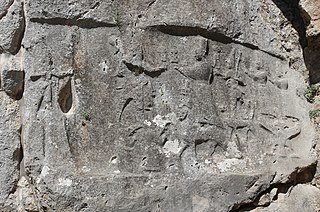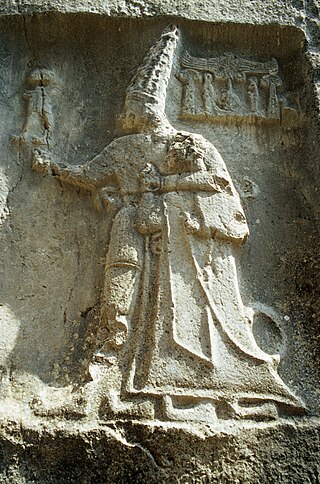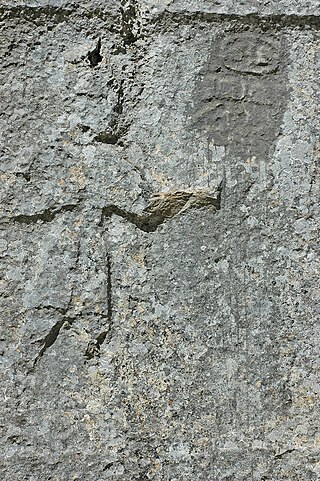Related Research Articles

Teshub was the Hurrian weather god, as well as the head of the Hurrian pantheon. The etymology of his name is uncertain, though it is agreed it can be classified as linguistically Hurrian. Both phonetic and logographic writings are attested. As a deity associated with the weather, Teshub could be portrayed both as destructive and protective. Individual weather phenomena, including winds, lightning, thunder and rain, could be described as his weapons. He was also believed to enable the growth of vegetation and create rivers and springs. His high position in Hurrian religion reflected the widespread importance of weather gods in northern Mesopotamia and nearby areas, where in contrast with the south agriculture relied primarily on rainfall rather than irrigation. It was believed that his authority extended to both mortal and other gods, both on earth and in heaven. However, the sea and the underworld were not under his control. Depictions of Teshub are rare, though it is agreed he was typically portrayed as an armed, bearded figure, sometimes holding a bundle of lightning. One such example is known from Yazılıkaya. In some cases, he was depicted driving in a chariot drawn by two sacred bulls.

Šarruma, also romanized as Šarrumma or Sharruma, was a Hurrian god. He could be depicted in both anthropomorphic form, sometimes riding on the back of a leopard, and in the theriomorphic form as a bull. His character is not fully understood, though it is known that he could function as a mountain god. He was regarded as a son of Ḫepat and Teshub. He was also linked to various moon deities. Additionally, the only mythological text he appears in addresses him as a messenger (sukkalu) of Kumarbi. He was worshiped by Hurrians in southeastern Anatolia and northern Syria, for example in Kummanni and Lawazantiya in Kizzuwatna. From this kingdom he was introduced to the Hittite pantheon as well. Hittite influence in turn resulted in his introduction to cities such as Aleppo, Emar and Ugarit. He was also venerated in Luwian religion in the first millennium BCE, with theophoric names invoking him attested from as late as the Hellenistic period in Cilicia and Lycia.

Ḫepat was a goddess associated with Aleppo, originally worshiped in the north of modern Syria in the third millennium BCE. Her name is often presumed to be either a feminine nisba referring to her connection to this city, or alternatively a derivative of the root ḫbb, "to love". Her best attested role is that of the spouse of various weather gods. She was already associated with Adad in Ebla and Aleppo in the third millennium BCE, and in later times they are attested as a couple in cities such as Alalakh and Emar. In Hurrian religion she instead came to be linked with Teshub, which in the first millennium BCE led to the development of a tradition in which she was the spouse of his Luwian counterpart Tarḫunz. Associations between her and numerous other deities are described in Hurrian ritual texts, where she heads her own kaluti, a type of offering lists dedicated to the circle of a specific deity. She commonly appears in them alongside her children, Šarruma, Allanzu and Kunzišalli. Her divine attendant was the goddess Takitu. In Hittite sources, she could sometimes be recognized as the counterpart of the Sun goddess of Arinna, though their respective roles were distinct and most likely this theological conception only had limited recognition. In Ugarit the local goddess Pidray could be considered analogous to her instead.
Kumarbi, also known as Kumurwe, Kumarwi and Kumarma, was a Hurrian god. He held a senior position in the Hurrian pantheon, and was described as the "father of gods". He was portrayed as an old, deposed king of the gods, though this most likely did not reflect factual loss of the position of the head of the pantheon in Hurrian religion, but only a mythological narrative. It is often assumed that he was an agricultural deity, though this view is not universally accepted and the evidence is limited. He was also associated with prosperity. It was believed that he resided in the underworld.

Kušuḫ, also known under the name Umbu, was the god of the moon in Hurrian pantheon. He is attested in cuneiform texts from many sites, from Hattusa in modern Turkey, through Ugarit, Alalakh, Mari and other locations in Syria, to Nuzi, located near modern Kirkuk in Iraq, but known sources do not indicate that he was associated with a single city. His name might be derived from the toponym Kuzina, possibly the Hurrian name of Harran, a city in Upper Mesopotamia, but both this etymology and identification of this sparsely attested place name remain uncertain. He was a popular, commonly worshiped god, and many theophoric names invoking him are known. In addition to serving as a divine representation of the moon, he was also associated with oaths, oracles and pregnancy. Some aspects of his character were likely influenced by his Mesopotamian counterpart Sin, while he in turn was an influence on the Ugaritic god Yarikh and Luwian Arma.
Earth and Heaven were worshiped by various Hurrian communities in the Ancient Near East. While considered to be a part of the Hurrian pantheon, they were not envisioned as personified deities. They were also incorporated into the Mesopotamian pantheon, possibly during the period of Mitanni influence over part of Mesopotamia, and under the names Hahharnum and Hayyashum appear in a variety of texts, including the myth Theogony of Dunnu.

Šauška (Shaushka), also called Šauša or Šawuška, was the highest ranked goddess in the Hurrian pantheon. She was associated with love and war, as well as with incantations and by extension with healing. While she was usually referred to as a goddess and with feminine titles, such as allai, references to masculine Šauška are also known. The Hurrians associated her with Nineveh, but she was also worshiped in many other centers associated with this culture, from Anatolian cities in Kizzuwatna, through Alalakh and Ugarit in Syria, to Nuzi and Ulamme in northeastern Mesopotamia. She was also worshiped in southern Mesopotamia, where she was introduced alongside a number of other foreign deities in the Ur III period. In this area, she came to be associated with Ishtar. At a later point in time, growing Hurrian influence on Hittite culture resulted in the adoption of Šauška into the Hittite state pantheon.

Allani, also known under the Akkadian name Allatu, was the Hurrian goddess of the underworld. She was also associated with the determination of fate. She was closely linked with Ishara, and they could be invoked or receive offerings together. She also developed connection with other underworld deities from neighboring cultures, such as Mesopotamian Ereshkigal, Anatolian Sun goddess of the Earth and Lelwani, and possibly Ugaritic Arsay. It is presumed she was chiefly worshiped in western areas inhabited by the Hurrians, though the location of her main cult center is uncertain. She is attested in texts from sites such as Tigunani, Tuttul and Ugarit. She was also incorporated into the Mesopotamian pantheon, and was venerated in Ur, Nippur and Sippar. Hittite sources mentioning her are known too.

The Hurrian religion was the polytheistic religion of the Hurrians, a Bronze Age people of the Near East who chiefly inhabited the north of the Fertile Crescent. While the oldest evidence goes back to the third millennium BCE, it is best attested in cuneiform sources from the second millennium BCE written not only in the Hurrian language, but also Akkadian, Hittite and Ugaritic. It was shaped by the contacts between Hurrians and various cultures they coexisted with. As a result, the Hurrian pantheon included both natively Hurrian deities and those of foreign origin, adopted from Mesopotamian, Syrian, Anatolian and Elamite beliefs. The culture of the Hurrians was not entirely homogeneous, and different local religious traditions are documented in sources from Hurrian kingdoms such as Arrapha, Kizzuwatna and Mitanni, as well as from cities with sizeable Hurrian populations, such as Ugarit and Alalakh.

Šimige was the Hurrian sun god. Known sources do not associate him with any specific location, but he is attested in documents from various settlements inhabited by the Hurrians, from Kizzuwatnean cities in modern Turkey, through Ugarit, Alalakh and Mari in Syria, to Nuzi, in antiquity a part of the kingdom of Arrapha in northeastern Iraq. His character was to a large degree based on his Mesopotamian counterpart Shamash, though they were not identical. Šimige was in turn an influence on the Hittite Sun god of Heaven and Luwian Tiwaz.

Nupatik, in early sources known as Lubadag, was a Hurrian god of uncertain character. He is attested in the earliest inscriptions from Urkesh, as well as in texts from other Hurrian settlements and Ugarit. He was also incorporated into Hittite religion. A similarly named deity continued to be venerated in Arbela as late as in the Neo-Assyrian period.
Ugur was a Mesopotamian god associated with war and death, originally regarded as an attendant deity (sukkal) of Nergal. After the Old Babylonian period he was replaced in this role by Ishum, and in the Middle Babylonian period his name started to function as a logogram representing Nergal. Temples dedicated to him existed in Isin and Girsu. He was also worshiped outside Mesopotamia by Hurrians and Hittites. He might also be attested in sources from Emar.
Kiaše, also spelled Kiaže or Kiyaši was a Hurrian deity representing the sea. Sometimes in modern scholarship, he is simply referred to as "the Sea" or "the Sea God."

Nabarbi or Nawarni was a Hurrian goddess possibly associated with pastures. She was one of the major deities in Hurrian religion, and was chiefly worshiped in the proximity of the river Khabur, especially in Taite. It has been proposed that she was associated with the goddess Belet Nagar, linked to the Upper Mesopotamian city of Nagar. In addition to being venerated in Hurrian religion, she was also incorporated into the beliefs of the Hittites and into the local pantheon of Emar. She also continued to be worshiped in Taite in the Neo-Assyrian period, as attested in a text from the reign of Ashurbanipal, where she is one of the deities invoked to bless the king.
Takitu, Takiti or Daqitu was a Hurrian goddess who served as the sukkal of Ḫepat. She appears alongside her mistress in a number of Hurrian myths, in which she is portrayed as her closest confidante. Her name is usually assumed to have its origin in a Semitic language, though a possible Hurrian etymology has also been proposed. She was worshiped in Hattusa, Lawazantiya and Ugarit.
Tašmišu (Tashmishu) was a Hurrian god. He was regarded as a brother of Teshub, and it is assumed he had a warlike character.
Ḫešui, also known as Ḫišue, was a Hurrian war god. He was also incorporated into the Hittite pantheon. He is sparsely attested in known sources, and his origin and the meaning of his name remain unknown.
Šeri and Ḫurri were a pair of theriomorphic Hurrian gods who almost always appear together in known sources. They were believed to pull the chariot of Teššub, the Hurrian weather god. Šeri additionally could function as a deity mediating between petitioners and his master, but no individual role was ever assigned to Ḫurri. In addition to appearing in Hurrian offering lists and theophoric names, for example from Nuzi, Šeri and Ḫurri are also attested in Hittite and Mesopotamian sources. While the Hittites incorporated them into their pantheon alongside Teššub and other deities from his circle, in Mesopotamia they instead came to be associated with Adad.
Tenu was a Hurrian god regarded as a divine attendant (sukkal) of Teshub. He might have originated in a local tradition typical for Aleppo. He appears in a number of Hurrian offering lists (kaluti), as well as Hittite and Emariote texts.
References
- 1 2 3 4 5 6 7 8 Schwemer 2001, p. 483.
- ↑ Wilhelm 2014, p. 45.
- ↑ Schwemer 2001, p. 69.
- 1 2 Taracha 2009, p. 67.
- 1 2 Haas 2015, p. 318.
- ↑ Schwemer 2008, p. 6.
- ↑ Haas 2015, p. 91.
- ↑ Schwemer 2008, pp. 6–7.
- ↑ Taracha 2009, p. 120.
- ↑ Schwemer 2001, p. 459.
- ↑ Schwemer 2001, p. 478.
- ↑ Haas2015, pp. 317–318.
- 1 2 3 Wilhelm 2014, p. 46.
- 1 2 3 Lambert 2007, p. 169.
- ↑ Richter 2010, p. 507.
- ↑ Wilhelm 1998, p. 123.
- ↑ Wilhelm 1998, p. 124.
- ↑ Schwemer 2001, p. 467.
- ↑ Deiner 1976, p. 34.
- ↑ Wilhelm 1998, p. 122.
- ↑ Bartelmus 2017, p. 310.
- ↑ Krebernik 2014, p. 45.
- ↑ Haas 2015, p. 319.
- ↑ Schwemer 2001, pp. 483–484.
- ↑ Lambert 2007, p. 172.
- ↑ Lambert 2007, pp. 167–170.
Bibliography
- Bartelmus, Alexa (2017). "Die Götter der Kassitenzeit. Eine Analyse ihres Vorkommens in zeitgenössischen Textquellen". Karduniaš. Babylonia under the Kassites. De Gruyter. pp. 245–312. doi:10.1515/9781501503566-011. ISBN 9781501503566.
- Deiner, Karlheinz (1976). "Materialien zu den Lokalpanthea des Königreiches Arrapḫe". Orientalia. 45. GBPress - Gregorian Biblical Press: 33–45. ISSN 0030-5367. JSTOR 43074680 . Retrieved 2022-06-19.
- Haas, Volkert (2015). Geschichte der hethitischen Religion. Handbook of Oriental Studies. Section 1: The Near and Middle East (in German). Brill. ISBN 978-90-04-29394-6 . Retrieved 2022-03-05.
- Krebernik, Manfred (2014), "Tilla A", Reallexikon der Assyriologie (in German), retrieved 2022-03-05
- Lambert, Wilfred G. (2007). "An Exotic Babylonian God-List". Studies presented to Robert D. Biggs, June 4, 2004. Chicago, Illinois: Oriental Institute of the University of Chicago. ISBN 978-1-885923-44-8. OCLC 67873765.
- Richter, Thomas (2010). "Ein Hurriter wird geboren... und benannt". In Becker, Jörg; Hempelmann, Ralph; Rehm, Ellen (eds.). Kulturlandschaft Syrien: Zentrum und Peripherie. Festschrift für Jan-Waalke Meyer (in German). Münster: Ugarit-Verlag. ISBN 978-3-86835-034-0. OCLC 587015618.
- Schwemer, Daniel (2001). Die Wettergottgestalten Mesopotamiens und Nordsyriens im Zeitalter der Keilschriftkulturen: Materialien und Studien nach den schriftlichen Quellen (in German). Wiesbaden: Harrassowitz. ISBN 978-3-447-04456-1. OCLC 48145544.
- Schwemer, Daniel (2008). "The Storm-Gods of the Ancient Near East: Summary, Synthesis, Recent Studies: Part II". Journal of Ancient Near Eastern Religions. 8 (1). Brill: 1–44. doi:10.1163/156921208786182428. ISSN 1569-2116.
- Taracha, Piotr (2009). Religions of Second Millennium Anatolia. Harrassowitz. ISBN 978-3447058858 . Retrieved 2022-03-05.
- Wilhelm, Gernot (1998), "Name, Namengebung D. Bei den Hurritern", Reallexikon der Assyriologie (in German), retrieved 2023-06-07
- Wilhelm, Gernot (2014), "Tilla B. Hethitisch, Hurritisch", Reallexikon der Assyriologie (in German), retrieved 2022-03-05